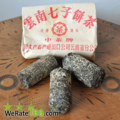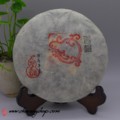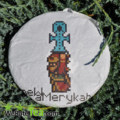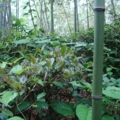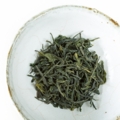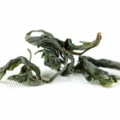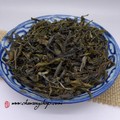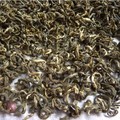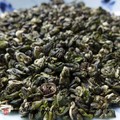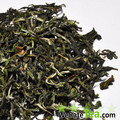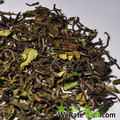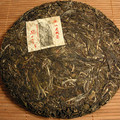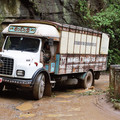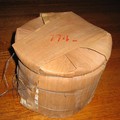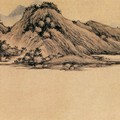2014 - 3 and more stars
Tea by type
Tea by region
Tea by years and other
2014 Autumn Mengsong Bamboo Raw Puerh Tea 500g
 1 review
1 reviewThis tea come from autumn 2014 harvest from Mengsong (Menghai), blend of tea from different villages, trees 60-80 years old, made by Dai minority. Put the tea into bamboo tube, then bake bamboo on the fire until lightly toasted. Press the tealeaves with a wooden stick when they are softened, and then fill up the tube again with more tealeaves. Repeat this procedure until tealeaves in the tube are compacted. Sweet, full tea soup with strong floral aroma. Drink now...
2014 Chawangpu "Lao Yu" Xiao Bing Cha
 1 review
1 reviewLao Yu (老妪) : old woman Material for this cake came from a small Bulang minority village in Bada mountain. This village have very small quantity of tea trees that grow in the forest. Trees are relative old, but farmers cut the branches when trees get too tall. Tea trees are kept at easy-picking height because the tea is picked and made by old women in this village. They follow ancient ways to produce tea. Many of them make tea only for themself. We selected and...
2014 White2Tea New Amerykah 2
 1 review
1 reviewAn old arbor Menghai blend. Thick body, lingering kuwei [pleasant bitterness], and plenty of oomph. This tea is a continuation of last year’s New Amerykah. The blend is slightly different, focusing more on sweetness and body than on bitterness.
SeJak 2014 ECO Korea
 1 review
1 reviewKorean green tea picked in the spring of 2014 in Hadong district, Jiri mountains. Grown and produced by an organic, one of the best small tea companies making all-hand made tea in the area. The tea leaves were packed in the tea farm so that the very freshness is provided. The tea gives several, even 5-6 good tea brews. Its making (a way of producing it) preserves his freshness even for more that a year. SeJak 'grade' refers to one of the first flushes that is performed from April...
JungJak 2014 ECO Korea
 1 review
1 reviewKorean green tea picked in the spring of 2014 in Hadong district, Jiri mountains. Grown and produced by an organic, one of the best small tea companies making all-hand made tea in the area. The tea leaves were packed in the tea farm so that the very freshness is provided. The tea gives several, even 5-6 good tea brews. Its making (a way of producing it) preserves his freshness even for more that a year. JungJak 'grade' refers to the second flush that is performed from May 1st to...
DaeJak 2014 ECO Korea
 1 review
1 reviewKorean green tea picked in the spring of 2014 in Hadong district, Jiri mountains. Grown and produced by an organic, one of the best small tea companies making all-hand made tea in the area. The tea leaves were packed in the tea farm so that the very freshness is provided. The tea gives several, even 5-6 good tea brews. Its making (a way of producing it) preserves his freshness even for more that a year. DaeJak 'grade' refers to the third flush that is performed as the last one,...
2014 Jingmai Gu Shu Huang Pian
 1 review
1 reviewThis tea is from Jingmai Da Zhai, grown in Da Ping Zhang area, and it is considered to be of the finest Jingmai tea available on market. We took few kilos of this Huang Pian to Kunming, where some of it we offer as loose leaves and rest will be pressed into the cakes. This raw puerh is the highest selection of older tea leaves ( Huang Pian - yellow leaves, or Da Ye Zi ). The older leaves, coming from the hundred year's trees, become bright yellow, red or orange tinted. The tea workers sort...
2014 Spring Te Ji Grade Lianghe "Hui Long" Green Tea
 1 review
1 reviewSelected grade famous high mountain green tea from Huilong Zhai, Dachang village, Lianghe county, Dehong prefecture. Huilong village, land area 1.28 square kilometers, elevation 1650 meters, average annual temperature 14.9 ℃, annual precipitation 1491.6 mm. Strong spicy fragrance of dry leaves. Pick one bud and one leaf or one bud/two leaves. This tea is very good for experimenting with little cooler water ! Low temperature make this tea milky cloudy, full in mouth...
2014 Yunnan Simao Huoqing Green Tea
 1 review
1 reviewSpring comes to Yunnan earlier this year. And also spring teas from regular spring harvest are picked a bit early.This good quality green tea comes from Simao area and was picked in late February. Picked one bud and two leaves. Commercial name for this tea is Bi luo chun in Kunming market, but we feel this tea doesn't look like original Biluochun, and the taste is not similar either. We call this tea Huoqing, because the look of jade green leaves is very similar to Yongxi Huoqing (涌溪火青,...
2014 Yunnan Zao Chun
 1 review
1 review"Early Spring" - fresh green tea from higher elevations near Yun Pan Shan (1100m) in early spring harvest. Nice uniform leaves with a moderate share of silver fluffy tips. Leaves with a lightly fruity aroma, infusion with crisp pickle-green color, fresh delicate taste with a hint of typical chestnut blossoms fragrance.
2014 Darjeeling Rohini Exotic SFTGFOP1
 1 review
1 reviewExclusive collection of the youngest gardens in Darjeeling processed from fresh buds of cultivar AV2. The golden infusion heady fragrance with notes of fruit, flowers lime and traces of peanuts. Sweet and smooth, balanced taste of ripe fruit with hints of grape which continues until lightly honeyed tones. The first breeze of spring in a cup of tea! Garden Rohini is situated in a valley Kurseong and has an eventful history. It was closed for 30 long years from 1962...
Theme
Quotes
„Mr. Gao showed us how to identify gu shu (ancient tree) tea leaves by looking at their texture, rubbing them between your fingers, and eating them raw. Old tea trees produce thicker, more leathery leaves that don’t easily come apart when you rub them. And gu shu buds should be white & shiny. When you chew them, the flavor is very bitter but there is also a strong sweet fragrance, and the juice is relatively easy to swallow. Tai di cha (terrace plantation tea) is also bitter but with a strong, lasting astringency on the sides & front of the tongue, and the juice is harder to swallow.“
Latest posts
01.01.2016 @ 18:14:35 - Eternal Spring:
WeRateTea.com wish you all the best for 2016!...
07.12.2015 @ 09:07:02 - sypalino:
I decided to taste this tea 2 weeks after delivery. The cake is lightly pressed, so...
09.11.2015 @ 21:58:19 - Eternal Spring:
Comparison of 2013 Bada Pu-erh.sk with <a...
09.11.2015 @ 09:34:07 - Eternal Spring:
Lao Yu 2013 is now about 2,5 years old tea and out of this 1,5 year stored in Europe....
09.11.2015 @ 09:33:11 - Eternal Spring:
Comparison of all three Lao Yu is now done :)
15.10.2015 @ 11:06:37 - Eternal Spring:
2015 Chawangpu Collection – I can only tell, that all teas are very good :)
09.10.2015 @ 10:31:19 - Eternal Spring:
It was quite long and difficult tasting to make a decision… There is still quite...
24.01.2015 @ 16:55:57 - Eternal Spring:
WeRateTea.com wish you all the best for 2015!...
30.12.2014 @ 17:19:22 - Eternal Spring:
"FT(For Taiwan)" means this brick was a special order of "Fei Tai" Company. Fei Tai...
13.08.2014 @ 18:24:28 - Eternal Spring:
We compared two teas from Youle. 2005 Jinuo Shan You Le "Red Sun Drum" and 2009...
Tea by region
We will help you with tea selection.
Do you like quality loose tea?
We will help you to find the right one for you. Be inspired by tea ratings of other tea lovers. Rating stars could help you.


Review your cup of tea.
Review the tea you are drinking and help other tea lovers to find the right cup of tea.






 Shops
Shops
